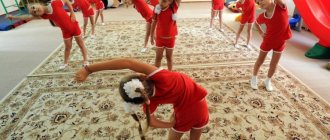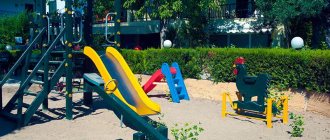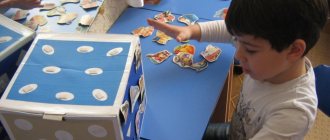| AUTUMN |
| Topic: “Autumn. What do you know about her? Questions for the conversation. - Do you know what day (according to the calendar) autumn begins?
- What is autumn like?
- Which animal gives birth to its young in autumn, during leaf fall? (A hare’s autumn babies are called deciduous ones).
- Where do butterflies, mosquitoes, and midges disappear in the fall? (Some butterflies pupate, some beetles lay larvae and die, some insects hide in the cracks of buildings, under the bark of trees, and thus overwinter.)
- What animal dries mushrooms on its trees to create winter supplies? (Squirrel)
- Where do frogs go for the winter? (fall asleep in silt at the bottom of reservoirs)
- What birds come to us from the north in late autumn and winter?
- What is worse for birds – hunger or cold?
- How do trees prepare for winter?
- Which tree leaves turn red in autumn?
- How do ants prepare for winter?
- From what animals do collective farmers fence off haystacks in the forest and meadows?
|
| Topic: “Trees in our yard” Questions for the conversation. - We can say that there are three states in the plant kingdom. Can you name them?
- What types of trees do you know? Why are some trees called deciduous? Why are other trees called deciduous? Why are other trees called conifers?
- What trees are called fruit trees? Why? After all, every tree has fruits?
- What deciduous trees can you name?
- What conifers do you know?
- What plants and trees do people like to eat the fruits of?
- Why are trees so important for humans and for all living things on the planet? What benefits do they bring?
- What things have people learned to make from wood?
- Why should trees be treated with care?
- Name your favorite tree. Why do you like it? Try to describe it, put it into words.
|
| Topic: “Walk in the Garden” Questions for the conversation. - What do we call fruit? What fruits do you know? What do you think is the difference between vegetables and fruits? What do they have in common?
- Name your favorite fruit. Do you know where it grows - on a tree branch, on a bush?
- Which fruit do you like best? Do you know how this vegetable is grown?
- What fairy tales do you know where fruits are the heroes? (When conducting a conversation, you can use the didactic game “Guess the vegetable (fruit) based on answers and questions.” In this game, the presenter guesses a vegetable, the other players try to guess it by asking questions:
size?
form? do you have a ponytail? What does the skin feel like? top or spine? what does it taste like? Which animal loves him? what is made from it? what can you prepare for the winter? By answering these questions, the presenter learns to accurately and completely express his thoughts, convey his feelings in words, and the playing children - guessing children - practice formulating questions and transforming figurative ideas into verbal descriptions.
|
| Topic: “Walk in the garden” Questions for the conversation. - What do we call vegetables? What do you think is the difference between vegetables and fruits? What do they have in common?
- Which vegetable do you like best? Do you know how this vegetable is grown?
- What fairy tales do you know where the heroes are vegetables? (When conducting a conversation, you can use the didactic game “Guess the Vegetable by Answers and Questions.” In this game, the presenter guesses a vegetable, the other players try to guess it by asking questions:
size?
form? do you have a ponytail? What does the skin feel like? top or spine? what does it taste like? Which animal loves him? what is made from it? what can you prepare for the winter? By answering these questions, the presenter learns to accurately and completely express his thoughts, convey his feelings in words, and the playing children - guessing children - practice formulating questions, transforming figurative ideas into verbal descriptions.)
|
| Topic: “Bread is the head of everything” Questions for the conversation. - Tell us how you understand this phrase: “Bread is the head of everything.” Why do they say this?
- Please remember the path bread takes before it reaches our table. What professions do people grow bread?
- What professions do people save bread? What are the names of the rooms where grain is stored?
- What do breeders do? Tell us about their work.
- What professions do people make bread and various flour products?
- What other products can be made from flour besides bread?
- What birds come to us from the north in late autumn and winter?
- Remember what sayings and proverbs you know about bread? (When conducting a conversation with children, special attention should be paid to how they understand the meaning of proverbs and sayings, the wisdom contained in them. Encourage children to use figurative expressions and synonyms in their answers.)
|
| Topic: “How we looked for mushrooms” Questions for the conversation. - Have you ever gone to the forest with your dad, mom, grandpa, grandma? Tell us what new things you saw and learned during this walk.
- What kind of forest was it - coniferous, deciduous or mixed? Which trees were there more - coniferous or deciduous?
- Remember what coniferous trees you saw in the forest.
- What kind of deciduous trees were there? By what signs did you distinguish them?
- What mushrooms did you find during this walk?
- Do you remember how adults picked mushrooms: did they carefully cut them with a knife or just tear them? How to pick mushrooms correctly?
- What else do you remember about this walk in the forest?
- Tell us what you did with the mushrooms after you returned home (to the dacha).
|
| Topic: “Late Autumn” Questions for the conversation.
- Listen to E. Trutneva’s poem “Autumn”, determine what time of year the poem is talking about.
- What is autumn like in September and October?
- What is autumn like in November? (Late, cold, damp, frosty.)
(O.A. Skorolupova. Autumn. Part 2) |
| WINTER |
| Topic: “Where does the bear live?” Questions for the conversation. - What wild animals living in our forests do you know?
- Why do you think these animals are called wild?
- Remember how wild animals prepare for winter?
- Do you think that among wild animals there are useful and harmful, useless, unnecessary?
- Folk tales, proverbs and sayings often talk about animals. For example: “No matter how much you feed the wolf, he keeps looking at the forest.” Do you think this saying only refers to the wolf?
- Which wild animal is considered the most cunning? What habits of a fox make it considered cunning?
- Which animal is called the most timid and cowardly? In fact, is the hare as cowardly as they think he is?
- Remember, the heroes of which fairy tales are wild animals? Try to tell one of them.
|
Subject:
"Winter Signs"
Questions for the conversation.- Name the winter months and make up a “winter word” from the first letters of their names.
- Name the first signs of winter. When we say: “Winter has come!”
- Explain why it is so cold in winter? Are the Earth and the Sun close or far away in winter? How much heat from the sun reaches Earth in winter?
- Why do days become shorter and nights longer in winter?
- What is snow? Why does it snow and not rain in winter?
- Do trees grow in winter? How do you think why?
- What conditions are generally necessary for plant growth? Do these conditions exist in winter?
- What do you think is the meaning of the proverb “Everyone is young in the cold of winter”? What do these words mean?
- What does the saying “The frost is not great, but it does not tell you to stand” mean?
- What proverbs and sayings do you know about winter?
- What winter sports do you know? Which ones do you like to do?
|
| Topic: “Have a fun, fun New Year!” Questions for the conversation. - Remember how you celebrated last New Year? What was your holiday like?
- What did Santa Claus bring to you, your sister (brother)?
- What shows have you attended?
- What do you remember most?
- A year is a very long time. This year you have matured by 1 year, and you are... years old! And how many interesting and new things you learned! Traveled so much! How many sweets did you eat? How many surprises you had! Think about the brightest events of the past year with mom and dad.
- Now let's dream. What do you expect from the holiday - New Year's Eve? Have you written a letter to Santa Claus? Did you invite him to visit? What shows will you be going to over the holidays? Who would you like to meet there? What to see?
Topic:
“New Year's Eve”
Questions for the conversation. - “Guys, look at the festively decorated group! What holiday will be soon?
- “Guys, why do you think the group should be decorated for the holiday?”
- “I come with gifts, shining with bright lights.
Dressy, funny, I’m in charge for the New Year! Guess who I am? - “Why do you think the Christmas tree will come to us?”
- “What do you think New Year means to you? Why do you need to decorate the Christmas tree? Who is Santa Claus? Where does Santa Claus live?
- “Guys, remember and name the fairy tales where I appear as a fairy-tale hero!”
- “How do people congratulate each other on New Year’s Day?”
- “What profession does a person help people receive letters, postcards, telegrams from relatives, close people, friends?”
- “Remember who in the familiar cartoon was the postman who had great adventures, but delivered a letter to Santa Claus from the guys?”
- “Perhaps you also want to ask Santa Claus for something for the New Year?”
- “Okay, guys, let's turn our Snowman into a Postman, attach a mail bag to the Snowman
|
| Topic: “Funny stories about kind animals.” Questions for the conversation. - Look carefully at these photographs and pictures. Which of these animals would you like to write a story about?
- Look at this lion (monkey, hippopotamus, rhinoceros, tiger, etc.). Let's try to imagine his character. Do you think he is good or evil? Cunning or simple-minded? Smart or stupid? Happy or sad?
- What other character traits do you think he has?
- Let's come up with a story that happened to this beast one spring day.
- Why did this particular story happen to him, do you think?
- Or maybe this story has a different ending? Cheerful or sad, happy or unlucky?
During the conversation, monitor whether children construct phrases and sentences correctly, whether they correctly agree adjectives and numerals with nouns. Develop the ability to adhere to the chosen plot line in a story. |
| Topic: “Barnyard Inhabitants” Questions for the conversation. - What pets do you know?
- Why do you think these animals are called pets?
- Why did people start breeding domestic animals? How did they first appear in humans?
- How does a person care for pets? (Feeds, builds housing, heals.)
- What kind of food are given to pets?
- What are pets' homes called?
- Do you think a cow, goat, pig, sheep can live with a person in the city?
- Remember which fairy tales talk about pets? Try to tell one of them.
|
Subject:
"Cars on our street"
Questions for the conversation.- Please remember the rules of behavior for people on city streets;
- Tell us about the rules for crossing the roadway;
- What cars have you seen on your street? Describe what they look like;
- What types of urban transport do you know? Which of them belong to ground transport?
- What special purpose vehicles have you seen on your street? (Firefighters, ambulances, police, cleaning vehicles, “Products” and “Bread” vehicles);
- Why do you think fire trucks and ambulances don't obey normal traffic rules? Why are they allowed to drive through even a red traffic light?
- What road signs do you know that any driver should obey?
|
| Topic: “Your fairy ship” Questions for the conversation. - Imagine and describe your fairy-tale ship. First try to describe it in words, and then draw it on paper.
- What name will you give your ship? Why?
- What flag will be flown on the mast of your ship? What does it show?
- How will you decorate your ship?
- What is the purpose of your ship? What will it do - transport cargo or people, or will it be a warship, a fishing trawler, a refrigerator ship, a factory ship?
- What seas and oceans will your ship travel through? What fabulous ports should you visit?
Come up with some interesting story that happened to your ship. |
| Topic: “Air modes of transport” Questions for the conversation. - What types of air transport do you know?
- Do you know any story or fairy tale about human flight?
- Who was the first to fly in a hot air balloon?
- Who was the first to fly into space?
- Who was the first to walk on the moon?
- What fairy-tale flying machines do you know (the flying carpet, Baba Yaga’s stupa, the wooden horse, the Little Humpbacked Horse, etc.)?
- Do you think a balloon filled with air will fly as long as the air lifts it, as long as the wind blows, or until the warm air in the balloon cools?
|
| SPRING |
| Topic: “It’s spring on our street” Questions to the topic. - What signs of the coming spring did you notice on your street, on the site of the kindergarten, on a Sunday walk in the park?
- Tell us how the snow changes in early spring. And what happens to him then?
- Tell us how the snow changes in early spring. What happens to him then?
- Why does snow melt in spring?
- Why do you think the days get longer in spring? This is associated with an increase in air temperature (warming) and melting snow.
- What is the process of melting ice on rivers called? Why was he called that?
- Why are there so many cumulus clouds in the spring sky? There are many more of them than in winter or summer. And why were they called “cumulus”?
- Tell us why active plant growth begins in spring? What causes this? And why did they grow in winter, but seemed to be sleeping?
- Why do buds swell on trees and shrubs?
- What are the first spring flowers?
- Why do migratory birds that flew to warmer regions in the fall return to us again in the spring?
- What insects appear first in spring? Where were the insects in winter?
|
| Topic: “Spring. Spring flowers" Questions to the topic. - What signs can you name?
- What flowers appear first in the forest?
- What flowers are usually given on March 8?
- Name the spring flowers that you know.
|
| Topic: “Spring is coming to us with quick steps” Questions to the topic. - What signs of spring do you know?
- Why do days get longer in spring?
- What is causing the warming and melting snow?
- Why are there a lot of cumulus clouds in the spring sky?
|
| Topic: “Birds of Migratory” Questions for the conversation. - What migratory birds do you know that fly away from us in the fall and return in the spring?
- Why do you think birds leave us in the fall? In your opinion, what is worse for birds in winter – cold or hunger?
- What do migratory birds eat?
- Why do migratory birds that flew to warmer regions in the fall return to us again in the spring? What spring changes in nature do you think allow birds to return to their native lands?
- There are migratory birds that come to us in the fall and spend the winter with us. Do you know such birds that we often see in winter, but do not see in summer?
- Why do sedentary birds stay with us for the winter? What do they eat?
- How does the behavior of sedentary birds change in spring?
- What do birds do after migration?
You can offer children the game “Yes-no” or “which bird” using visual material: a child from the subgroup chooses one of the birds, the images of which are laid out on the table. Children ask him questions to which the leader can only answer “yes” or “no”: — Is this bird migratory? (Is this bird sedentary?) - Her breast is red7 (White, yellowish, etc.) -Does her wings point? (Are her wings rounded?) |
| Theme: “Seven Colors of the Rainbow” Questions to the topic . - We say “Seven colors of the rainbow”, “Paints of different colors”, “Colored pencils”, and at the same time - “Wildflowers”, “Bouquet of flowers”. Why do you think they use the same word “color” to refer to different things?
- Remember what states and how many exist in the great kingdom of plants?
- How do herbs and flowers benefit us?
- Do you think the beauty of flowers brings any benefit to people or is it meaningless and useless?
- What medicinal plants and flowers do you know? What diseases do they treat?
- Please remember fairy tales, poems, stories in which flowers and herbs play an important role.
Now try to compose a fairy tale yourself, in which your favorite flower would participate. When conducting a conversation, you need to pay special attention to how fully and accurately children answer the questions posed, and encourage the use of epithets and figurative expressions. |
| Topic: “Victory Holiday” Questions to the topic. - What do you know about this holiday?
- Who did we defeat?
- Why does the whole country celebrate this holiday every year?
- What is a military parade?
- Who are veterans?
- Tell us about your veteran relatives.
|
| Topic: “My family” Questions to the topic . - How do you understand the word “family”?
- How many people do you have in your family?
- Do you have brothers and sisters?
- Where do your grandparents live?
- How is your mother's mother related to you? And mom's dad?
- Who is older - you or mom? Mom or grandfather?
- Who is the youngest in your family? Who is the oldest?
- What fairy tales do you know where grandparents live?
|
| Topic: "Furniture" Questions for the conversation: - Name what we sit on, what we write on, where we store things, what is in the room, etc.
- How to call everything in one word?
- What are they made of?
- What tools are needed to make furniture?
- Name the professions.
|
| SUMMER |
| Topic: “The red summer has passed” Questions for the conversation. - Why do you think summer is called “red” and not “green”, for example?
- Name the summer months and make up a “summer word” from the first letters of their names.
- Name the signs of summer.
- How can you explain why it rains in summer and snows in winter?
- Why do the days get longer and the nights shorter in summer?
- Tell me what happens to plants in spring?
- What do the wild animals of our forests do in the summer?
- What proverbs and sayings do you know about summer?
- Tell us about your favorite summer activities.
- Where did you spend this summer? Where do you dream of going next summer?
|
| Topic: “Water on Earth” Questions for the conversation: - What bodies of water on our planet do you know?
- How does water in the seas and oceans differ from river and lake water?
- Did you know that bodies of water can also get sick, just like people? What do they get sick with and why do you think?
- What properties of water do you know?
- What do you think the water cycle is? Why do they say this?
- In what form can water be?
- Why does a person need water? How does it benefit people?
- Imagine what would happen if all water disappeared from the Earth?
|
| Topic: "Clothing" Questions for the conversation. - Name the clothes you are wearing.
- What kind of clothes are there?
- List outerwear.
- What do we wear in summer and winter? and etc.
|
| Topic: "Shoes" Questions for the conversation. - Name the shoes you are wearing.
- What kind of shoes are there?
- List indoor shoes, outdoor shoes, winter shoes, etc.
- What do we wear in summer and winter? and etc.
|
| Topic: “These amazing insects” Questions for the conversation. - Can you name the distinctive features of insects? How many legs do they have, what is their body made of, do they all have antennae?
- What types of insects do you know?
- Please remember what beneficial insects you know? ( Let's play the game “Recognize the insect”. You will have to remember the distinctive features of different types of insects. In this game, the teacher makes a guess about an insect, and the children must figure out:
— How does it move: flies, crawls, runs, jumps, swims? - What sounds does it make: buzzing, squeaking, chirping, silent? - What color is it: black, gray, green, yellow, speckled, striped, patterned? - What kind of body does he have: hard, smooth, shaggy, soft? - Does it sting, bite, tickle, harmless? — Does it live in a large family or in a small one? In the game you can use various pictures and rules of the “Yes-No” game.) - Why do migratory birds that flew to warmer regions in the fall return to us again in the spring?
- What insects appear first in spring? Where were the insects in winter?
|





